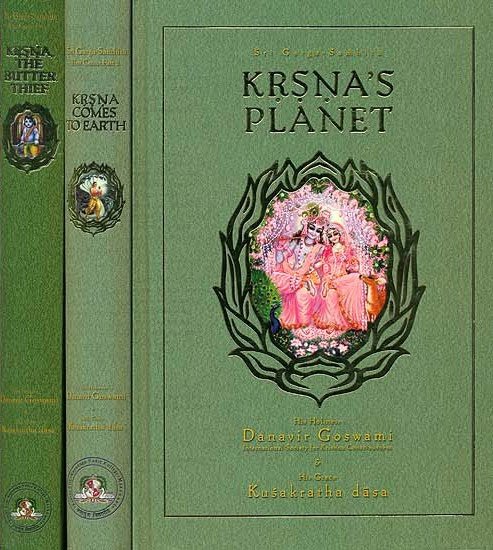Garga Samhita (English)
by Danavir Goswami | 425,489 words
The Garga-samhita Verse 4.8.17, English translation, including word-by-word: This text represents a Vaishnava scripture which narrates the life Krishna, It was composed in seventeen cantos by Garga Muni: an ancient sage and priest of the Yadu dynasty having. This is verse 4 of Chapter 8 (In the Story of the Yajna-sitas, the Glories of Ekadashi) of Canto 4 (madhurya-khanda).
Verse 4.8.17
Sanskrit text, transliteration and word-by-word meaning:
सर्व-सम्पत्-प्रदा चैव
द्वे प्रोक्ते मलमास-जे
एवं सद्-विंशतिं नाम्नां
एकादश्याः पठेच् च यः
सम्वत्सर-द्वादशीनां
फलम् आप्नोति सो ऽपि हि
sarva-sampat-pradā caiva
dve prokte malamāsa-je
evaṃ sad-viṃśatiṃ nāmnāṃ
ekādaśyāḥ paṭhec ca yaḥ
samvatsara-dvādaśīnāṃ
phalam āpnoti so 'pi hi
sarva-sampat-pradā—granting all auspoiciousness; ca—and; eva—indeed; dve—two; prokte—said; malamāsa-je—born from malamasa; evam—thus; ṣaḍ—- viṃśatim—26; nāmnām—names; ekādaśyāḥ—of ekādaśī; paṭhet—recites; ca—and; yah—whoever; samvatsara-dvādaśīnām—a year of ekādaśī; phalam—the result; āpnoti—attaiuns; saḥ—he; api—indeed; hi—indeed.
English translation of verse 4.8.17:
There are also two more ekādaśīs, both named sarva-sampat-pradā, during the extra month of leap-year. In this way there are twenty-six ekādaśīs in all. A person who chants the names of these twenty-six ekādaśīs attains the result of following ekādaśī for one year.
